In the wake of serving on the western front all through the Great War, Frank Hughes prepared as an electrical designer prior to establishing the business in Lowestoft, Suffolk, in 1921. Initially rewinding modern electrical engines for Lowestoft’s fishing armada, Frank purchased his first shop in 1928, where he assembled and sold radios while the family resided over the shop. The business was joined in 1946, yet the next year Frank died, leaving his youngsters Peter, Phyllis and Jim to assume control over the administration of the organization. Right up ’til the present time, just about 100 years on, we stay a genuine privately-owned company with the third era, under Robert and Jeremy Hughes, presently in charge. We rushed to embrace and present new innovations as they grew, for example, TVs and work saving kitchen apparatuses. By leasing these items, they became reasonable for the run of the mill family in the post-war grimness years. This early hardware was famously untrustworthy and the designing foundation of the organization implied that we were all around set to foster a huge help framework to fix them. Geographic extension before long followed and before the finish of the twentieth century we had more than 30 shops and five help places situated all through East Anglia.
The new thousand years carried with it new open doors and we extended our retail impression even further with the securing of Apollo 2000 (situated in the West Midlands) and Bennetts Retail (situated in East Anglia). These organizations worked from huge, away stores, which extraordinarily expanded our ability in the offer of kitchen apparatuses and IT hardware. This development implied that we are presently the country’s fourth biggest expert electrical retailer and the greatest supplier of home amusement and kitchen apparatus rentals. At Hughes, our stores are urged to assume a functioning part in their networks, routinely taking part in neighborhood noble cause occasions by means of raising money and the gift of much-required apparatuses close by supporting close by associations that have a positive effect in their particular towns. This remembers tracking down ways of reducing our effect for the planet, with electronic waste currently being one of the quickest developing waste streams, we are continually searching for ways of aiding the climate and become a greener organization. From introducing sun powered chargers and electric vehicle charging ports to effectively reusing cardboard, polystyrene and polythene, we are continuously searching for valuable chances to have a greener effect.
We were really glad to win the Domestic and General ‘Web Retailer of the Year’ Award in 2016, having been casted a ballot the best electrical site by in excess of 250,000 clients. Our business division, Hughes Trade, is one of the nation’s quickest developing and most regarded business-to-business electrical providers. This division was granted the agreement to be the favored provider of kitchen machines in the London 2012 Olympic Games and Glasgow 2014 Commonwealth Games mirroring its social affair achievement. We have likewise fostered a 80,000 sqft appropriation office in Thetford which upholds the shops, site, exchange and administration focuses, while holding our obligation to support, with north of 100 completely prepared electrical specialists. We were extremely glad to praise our 100th birthday celebration in 2021 and accept that this life span shows that the organization adage of “moving client steadfastness through quality client support” stays as pertinent and genuine today as when Frank Hughes initially established the business.
German Gear Maker Hughes & Kettner has long displayed an appreciation for classic tube-derived tones attained via alternative means. Several years ago, the company coupled tubes with solid-state and digital control methods and effects in its TubeMeister and GrandMeister series of über amps.
With the Spirit 200 amps of a couple years back, however, H&K’s thinking had evolved toward an ongoing appreciation of tube tone generated by the Spirit Tone Generator.
Developed by H&K’s chief developer Bernd Schneider, this solid-state technology is not modeling as we’ve come to know it – and, in fact, isn’t modeling at all – but a fully analog amplification system engineered to accurately mirror a tube’s response to the incoming electric guitar signal and deliver a similar tone and playing feel.
As embodied in the Black Spirit and Spirit Nano series, those results were impressive. Now H&K has placed the Spirit Tone Generator in its new AmpMan Classic pedal amplifier (the high-gain AmpMan Modern also available).
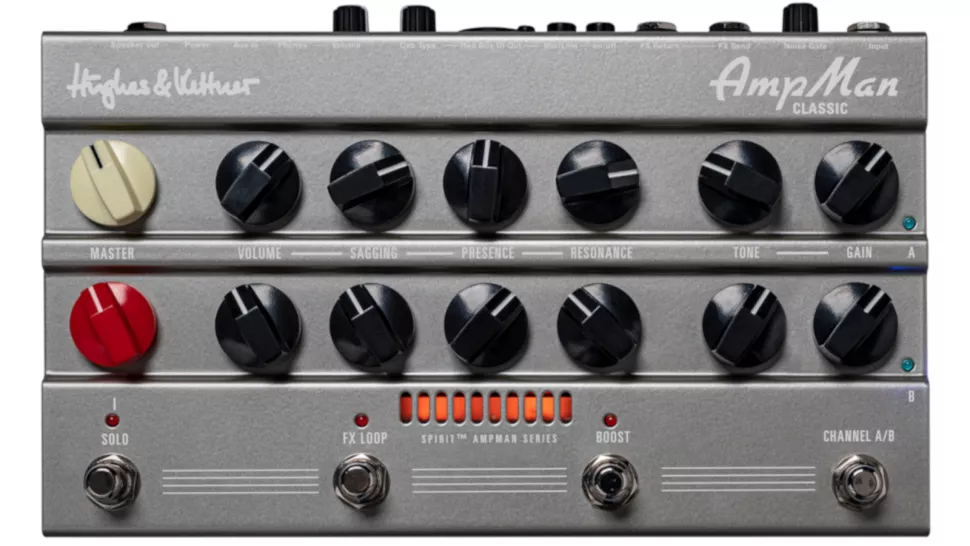
Comprising a two-channel amp in a 10 x 5.5 x 1.5-inch floor unit with impressive functionality, oodles of connectibility and a 50-watt power amp, it puts a lot of versatility under your toes.
For all that it offers, the AmpMan Classic attains its impressive price point mainly by being a WYSIWYG version of H&K’s more comprehensive Spirit-loaded offerings, such as the Black Spirit 200 Floor.
Rather than the bigger, more expensive Floor’s deeply programmable presets, seven foot switches, and several built-in effects, the AmpMan Classic delivers two foot-switchable channels, each with controls for gain, tone, resonance, presence, sagging and volume, with shared master and solo.
There are no presets, user patches or effects, but it does have a foot-switchable FX loop, boost and solo, plus many ways to connect the thing up.
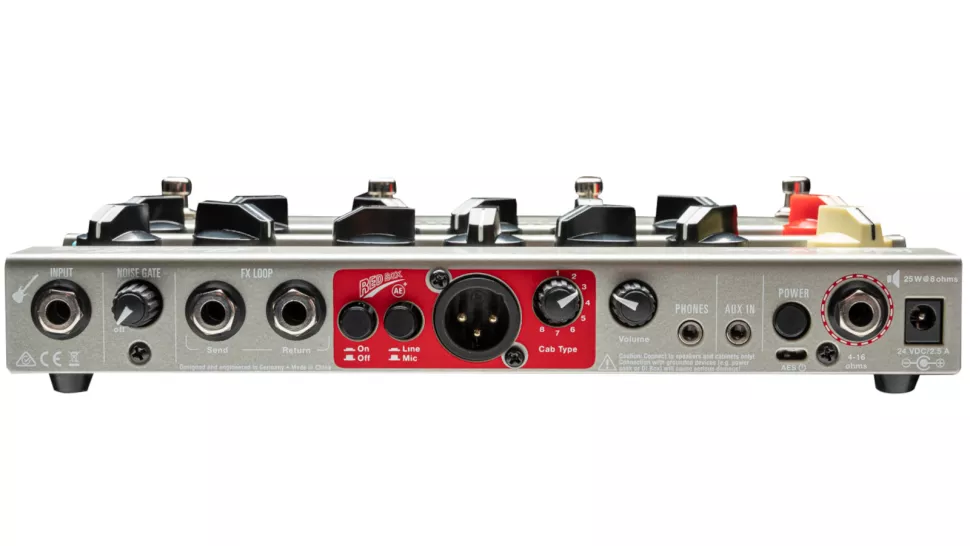
Narrow as it is, the AmpMan’s back panel is fully loaded with an input, a noise-gate level control, an FX loop send and return, the built-in H&K Red Box cab sim’s on/off switch, a line/mic switch, an XLR DI output and an eight-position cab-type selector.
There is also a 1/8-inch stereo headphone jack with volume, a 1/8-inch aux input, the power switch, and a power-amp output capable of generating 50 watts into four ohms, 25 watts into eight ohms, 12.5 watts into 16 ohms. Here is where you’ll also find the input for the included 24-volt DC power adapter.
Highlights of the design include the resonance control to fine-tune the low end, the sagging control to induce compression-like power-supply lag, and a selectable solo boost level with foot switch, which is extremely handy to help your leads cut through the band.
Most importantly – both to H&K and likely to many users – is the emphasis on the fact that this is all strictly analog stuff. While the company doesn’t pretend there are tubes inside that narrow perforated window between the knobs and the foot switches, whatever is in there gives off an enticing orange glow that implies it’s doing much the same thing.
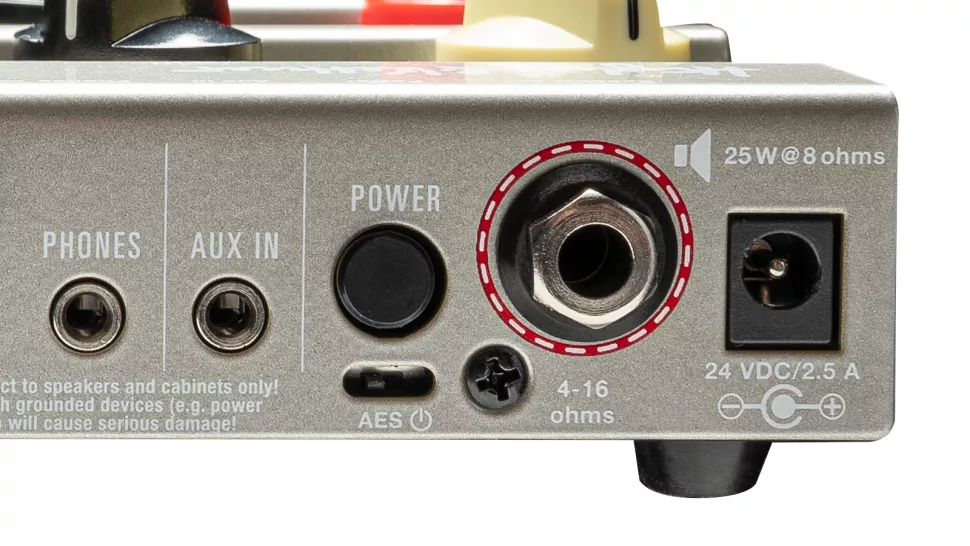
Using a Fender Telecaster and a Gibson Les Paul, we tested the AmpMan Classic through its headphone output, with its Red Box DI into a recording interface, and via the power-amp output into an open-back 1×12 cab with a Weber Blue Dog Alnico speaker.
What we found was an impressive range of useability. Before delving into sounds, though, a little semantics: Given its straightforward, amp-like control layout, the AmpMan is very easy to use, but the biggest hurdle comes from H&K’s labeling of the knobs.
In use, resonance and presence play more like traditional bass and treble controls, respectively, while the tone knob on each channel doesn’t dial in highs as you’d expect but, in H&K’s own words, “sweeps from British to Californian flavor.”
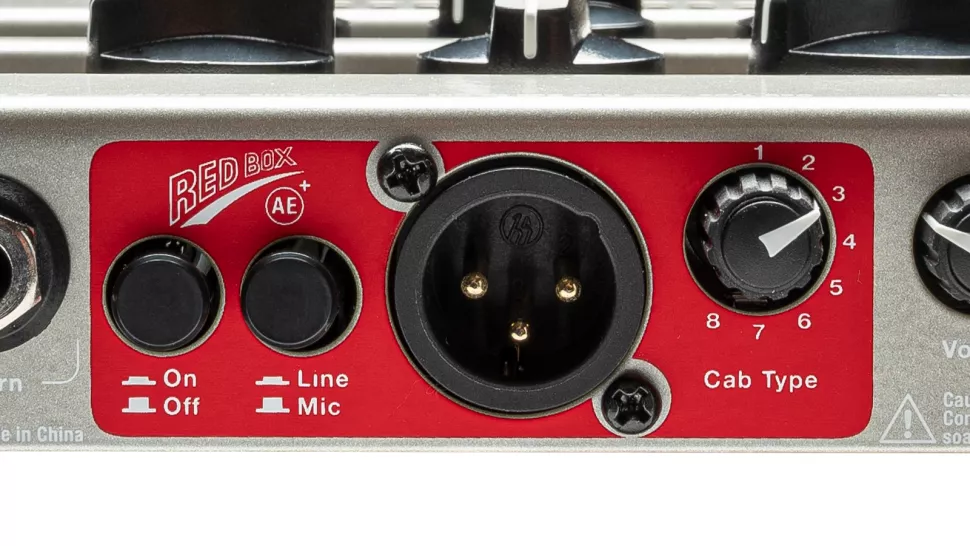
As for the sagging control, it might be the most easily misunderstood of them all. Whereas sag is the slight compression induced by an amp’s tubes and power supply at high volumes (a generally subtle effect that is felt more than heard), the sagging control takes the AmpMan Classic’s response from tight and dull to loose, raw and rather ragged.
While these are all useful controls, you’ll want to play with them a while to come to a full understanding of their functions and find your own sweet spots.
Once you do, the AmpMan Classic has a lot to offer for its price. We were immediately impressed with the clean tones on channel A, which segue into tasty, dynamic edge-of-breakup textures with the gain control advanced. The tone control takes them from Vox to black-panel Fender, all arguably the equal of many mid-level tube amps.
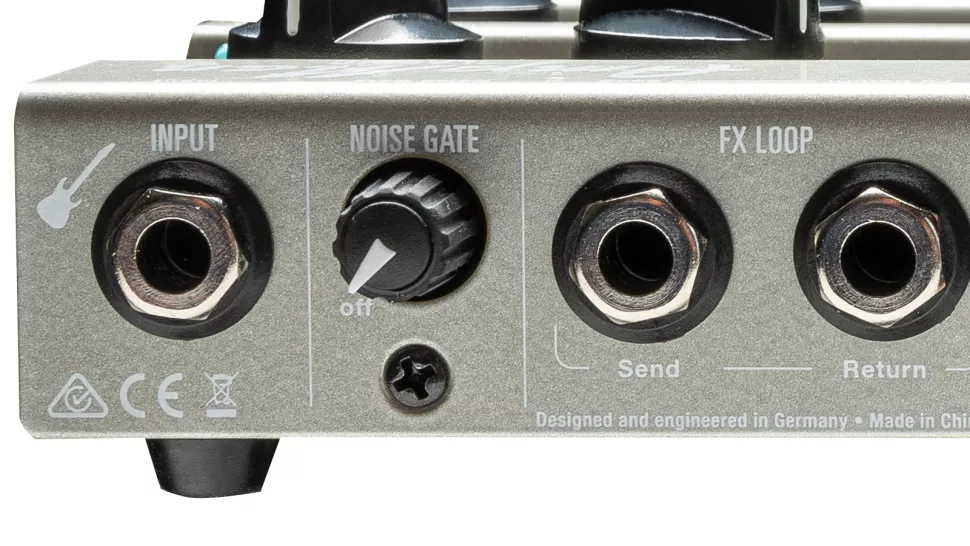
Channel B provides very playable crunch and lead tones and can achieve some really likeable renditions of both American and British pushed-amp overdrive with some careful application of the sagging control. Crank it with gain pushed up high, and things will get fizzy and fall apart, but there’s a broad range of voices in here before it all goes crazy.
The AmpMan Classic interacted well with a handful of overdrive pedals in front, and it handled common tremolo, delay and reverb pedals in its loop without issue. All in all, it really did sound and feel impressively tube-like too, although arguably more so into the headphones or DI’d into studio monitors, where it’s all taken a step away from our “amp in the room” expectations.
The built-in power amp sounded very good into the 1×12 extension cab with traditional guitar speakers, but it also gave us the impression of a tube preamp into a solid-state output stage, which is kind of what the pedal is emulating anyway, given that the Spirit Tone Generator isn’t applied to the unit’s power amp.
The 25 watts it delivered into the cab’s eight-ohm load provided enough oomph to hang with a drummer in a small club or rehearsal space, although not with the decibels we’ve achieved from many tube amps with similar ratings, or even somewhat less.
That said, it sounded very good, and it sure is a handy compact fly rig or easy-loading solution for gigs and rehearsals. Add it all up and it’s a ton of power, versatility and usability for the money, and it deserves an Editors’ Pick Award.
Specifications:
CHANNELS 2
CONTROLS Gain, tone, resonance, presence, sagging and volume on each channel. Shared master and solo controls. Foot-switches for channel A/B, boost, FX loop, and solo. Noise gate level; RedBox DI on/off switch, mic/line switch, XLR out, and eight-position rotary cab-selector; headphone volume, and power switch on back panel
POWER 50 watts into 4Ω, 25 watts into 8Ω, 12.5 watts into 16Ω
EXTRAS Noise gate, FX loop, built-in RedBox cab sim, aux in, headphone out
WEIGHT 7.8 lbs
BUILT Assembled in China
Hughes & Kettner TubeMeister 36 review
Hughes & Kettner TubeMeister 36
The so-called ‘lunchbox’ head has definitely been one of the biggest amplification stories around the world for the last five years or so, with many amplifier manufacturers adding a metal-bodied, small to medium-powered head to their catalogues.
Hughes & Kettner may have come late to the game, but its German-designed and Chinese-built TubeMeister range has been one of the success stories of the last year, generating significant positive publicity across the real and virtual worlds. We’ve already looked at the five-watt and 18-watt versions, now it’s time to ogle the amp that threatens to fire a howitzer into the mid-priced head market – the TubeMeister 36.
The most significant upgrade over the TM18 is the MIDI-in socket. All of the TubeMeister 36’s switched functions can be operated via MIDI, including the power soak
The TubeMeister 36 shares the same design format as its two smaller siblings with a robust steel chassis supporting two oversized transformers, four EL84 output valves and three 12AX7 preamp valves. Inside there are two main circuit boards: one holds all the valve bases and most of the amp circuitry, the second accommodates most of the rear panel equipment.
There are a couple of smaller PCBs that appear to hold the MIDI and digital effects stuff. The quality is typical of Hughes & Kettner’s high standard; all the boards are through-plated and they’re stuffed with high temperature electrolytic capacitors and close tolerance metal film resistors for durability, consistency and low noise.
The chrome front panel features the Hughes & Kettner hallmark-engraved clear Perspex fascia, which lights up in blue when the power goes on. Previously reserved for top-flight models such as the Triamp and Puretone, this either looks unbelievably cool, or not, depending on your taste. But coupled with the TubeMeister 1 x 12 enclosure, the head looks like it means business while also being small enough not to dominate a lounge or bedroom.
Further building upon the TubeMeister 18’s features, the 36-watt version offers three channels for clean, crunch and lead, each with separate gain and master volume controls. There are two three-band EQs – one for the clean channel, the other shared by crunch and lead.
Around the back, you’ll find a series of pushbutton switches for the TubeMeister’s built-in attenuator that progressively reduce output power from 36 watts down to 18, five, or one watt, with a mute switch. This disconnects the speaker but leaves the head’s built-in Red Box speaker emulator on for silent recording.
There’s also a switchable series effects loop, digital reverb, and Hughes & Kettner’s clever TSC (Tube Safety Control), which constantly monitors and micro-adjusts bias to ensure the amp is running at peak efficiency. In addition, a single speaker outlet and a pair of footswitch jacks operate channel-switching, reverb and loop functions.
However, the most significant upgrade over the TM18 is the MIDI-in socket. All of the TubeMeister 36’s switched functions can be operated via MIDI, including the power soak. The significance of that is immense because you can seamlessly go from a fat clean sound using all 36 watts for maximum headroom, through a slightly compressed crunch tone on 18 watts, to a fully saturated lead sound with the master cranked up on five watts, or any combination.
The Red Box speaker emulator offers a balanced output for easy connection to PA or recording equipment. There’s no ground-lift switch, which would have been the hundreds and thousands on top of an already well-iced cake, but it’s not a major inconvenience. Another slight disappointment is the lack of a MIDI out/thru socket, which means the TM36 can only accept incoming MIDI patch change commands.
All in, the TubeMeister is every bit as good on the inside as it is on the outside. It may originate from China, but it’s built to the same high standard that we’ve come to expect from all Hughes & Kettner products and should easily handle the rigours of non-stop gigging without any complaint.
Sounds
Using a variety of different guitars to test the TubeMeister 36, including our regular test-bed Strat, a Gibson Les Paul Standard with PAF humbuckers and a nicely yellowed 1970 Les Paul Custom, we found this head can sound as vintage or as modern as you like, with a definite American influence on the clean and crunch tones, while the lead channel is more in British territory, with a hint of another famous EL84-powered amp.
Being able to switch everything simultaneously using MIDI kicks the TubeMeister 36 into a different league
The clean channel is open and airy, with clarity that’s almost hi-fi at lower gain settings and sounds superb with a dash of chorus. With the gain turned up, the clean channel starts to growl a little – more so if you reduce the amp’s power output and turn up the channel volume.
Swap for humbuckers and there’s plenty of drive available to turn the clean channel into a second crunch channel. This overlaps nicely with the real crunch channel, which adds a good deal more overdrive and aggression, with plenty of bottom end from the dual-ported 1 x 12 cabinet. This Vintage 30-powered enclosure is very impressive; made from decent quality plywood, it sounds a lot bigger than it looks.
The lead channel adds even more gain for a singing overdrive with just the right amount of edge to add bite to dark guitars. On some other Hughes & Kettner amps, you need to work a bit to find your sound. However, on the TubeMeister it’s already there waiting for you – just a little fine-tuning from the smoothly interacting bass, mid and treble controls is all that’s needed.
The digital reverb sounds like it emulates a spring and works well for more pronounced effects as well as background ambience. The internal Red Box sounds good into a desk with minimal need for EQ.
It’s all good stuff, but being able to switch everything simultaneously using MIDI really kicks the TubeMeister 36 into a different league. We hooked it up to a BOSS GT-10 effects processor and in just a few minutes, the TubeMeister was automatically changing channels, power soak settings and reverb, as we swapped patches on the BOSS.
We reckon the TubeMeister 36 will tick all the boxes for many potential customers. There really isn’t much to criticise: we mentioned the lack of a MIDI out/thru socket earlier, the only other thing that we’re not sure about is the way Hughes & Kettner has shared the TubeMeister 36’s two EQs between three channels.
We think the lead channel would be more versatile with its own dedicated network, and the clean and crunch channels sharing the other EQ. But it’s not a major issue, as all three channels have excellent response and sound superb right out of the box.
Just as well, because there are some hot competitors in the tone department at the moment. However, none have MIDI switching and a multi-step attenuator that can also be remotely controlled – we think that’s a first and it makes the TubeMeister 36 a seriously versatile amp, especially when teamed with a good MIDI effects device.
If you’re looking for a mid-priced amp that really can do it all, the TubeMeister 36 deserves to be right at the top of your ‘must try’ list.
Our Price
We check the prices of our competitors every day to make sure that we are providing the very best deals for our customers. In addition to our great prices, we have exclusive voucher codes on selected products to give our loyal customers extra value for their money. We also have PayPal finance options to help spread the cost and have 4 months 0% finance available on products over £100.
Products
We offer a vast range of products, from TVs and soundbars to kitchen and laundry appliances, with items from all of the most popular household names including Samsung, LG, Sony, Miele and Hotpoint, among many more.
Delivery
We know that a lot of the products we offer are not the type that will fit through a letter box. For the majority of orders, our customers can choose their preferred delivery date and will receive a time window on the day. For parcels delivered by DPD, this can be as short as a 1-hour time period. If they cannot wait in for their delivery, we offer a convenient click and collect services from any of our stores and service centres.
Help and Advice
Buying a new television or appliance is not something that you do every day. With this in mind, we have a UK-based call centre with a fully trained, knowledgeable team to help our customers make the right purchase for their needs. We are available on the phone or via live chat to help pre- or post-purchase. We also have buying guides available to help our customers with their research. This can be viewed at https://www.hughes.co.uk/buying-guides
Hughes Rewards
Our customers can sign up for our Hughes Rewards program to be entered into our monthly prize draw with the chance to win £250 in Hughes vouchers. Sign up at https://www.hughes.co.uk/rewards
Find a store
Find your nearest store and collection point at www.hughes.co.uk/storefinder
